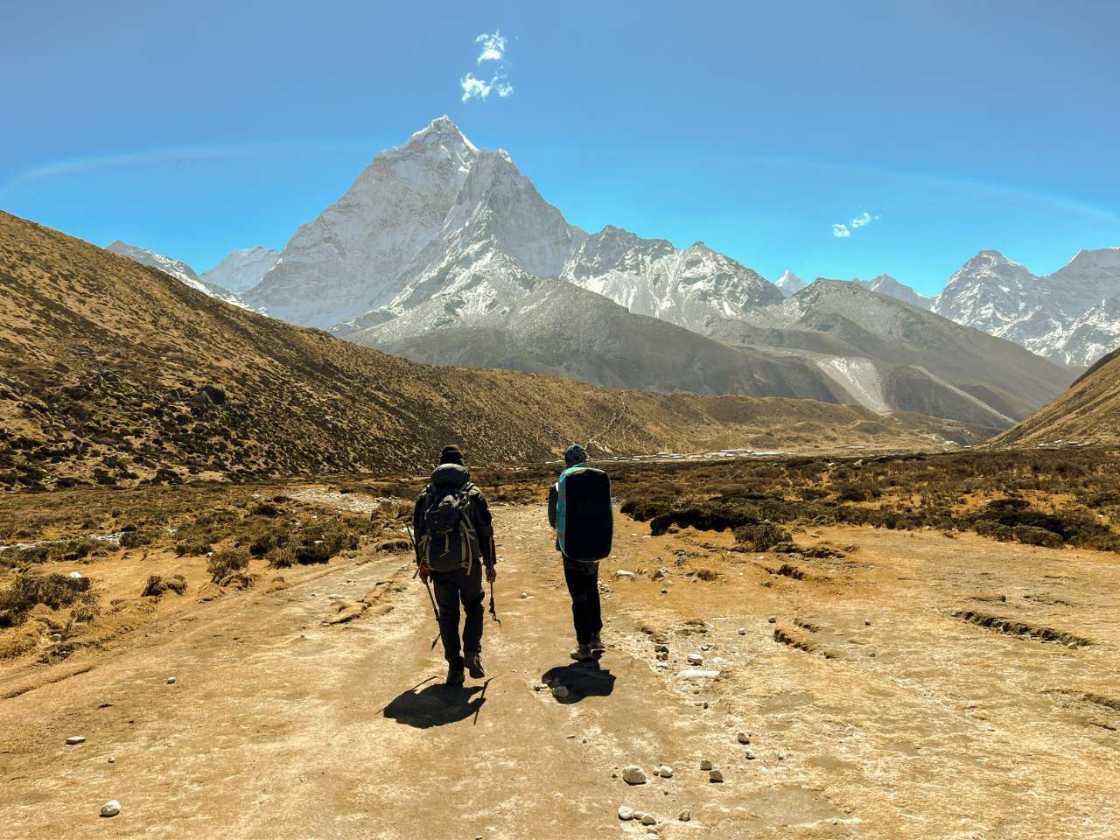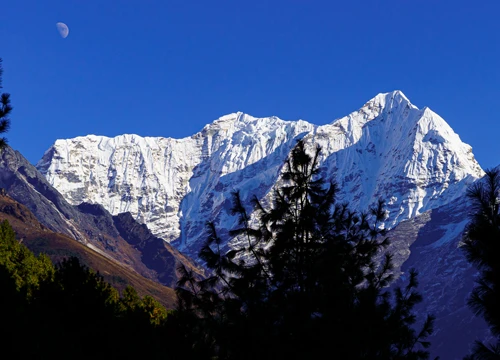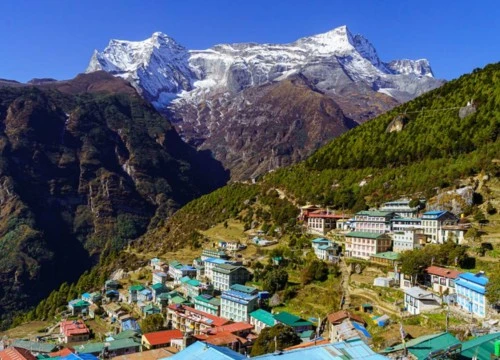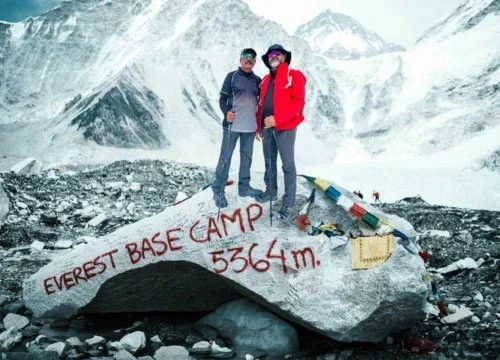What is the best time/season for Jiri to Everest Base Camp Trekking?
The optimum times to trek in Nepal are in the spring and fall, between the pre-monsoon and post-monsoon seasons, to reach Everest Base Camp. While the post-monsoon season starts in September and lasts until November, the pre-monsoon season starts in mid-February and lasts until May.
Trekking is ideal during these seasons because of the frequently dry, stable weather with clear skies and good visibility. At lower elevations, daytime temperatures range from 10 to 20 degrees Celsius, whereas at higher elevations, they are between 0 to 10 degrees Celsius.
Holiday Tours Nepal advises against trekking in the Jiri to Everest Base Camp Region during the monsoon season (June to August) due to the likelihood of landslides and flash floods, as well as the possibility of muddy and treacherous pathways. It's also not advisable to go during the winter months of December through January because the paths are prone to snow and ice and it may become rather chilly.
Holiday Tours Nepal generally recommends that the best time to trek from Jiri to Everest Base Camp is during the pre-monsoon and post-monsoon seasons because of the reliable weather and comfortable, warm temperatures.
Climate and Weather during Jiri to Everest Base Camp Trek
The weather in the Solu–Khumbu region varies greatly by season and elevation, creating different trekking experiences throughout the year.
Spring (March–May)
One of the best times to trek, with mild temperatures ranging from 17°C to 25°C. Clear skies, blooming rhododendrons, and excellent mountain views make this season ideal for photography and comfortable hiking.
Summer/Monsoon (June–August)
Warm temperatures up to 22°C, but heavy rainfall at lower elevations makes trails slippery and muddy. Higher areas receive less rain but often remain cloudy, limiting mountain views. Trekking is more challenging due to unpredictable weather.
Autumn (September–November)
The most popular trekking season. Stable weather, crystal-clear views, and temperatures between 6°C and 22°C. Although nights get cold at high altitudes, this season offers the best visibility of Everest and surrounding peaks.
Winter (December–February)
The coldest and least preferred season, with temperatures dropping as low as –17°C. Snow-covered trails, icy paths, and closed teahouses make the trek difficult and risky.

Altitude Sickness during the trek: Reasons and Precautions
The Jiri to Everest Base Camp trek is considered a tough trekking route. This is mainly due to high altitude and difficult trekking trails. Acute Mountain Sickness (AMS) is a major problem for trekkers travelling in Everest region due to lack of Oxygen in high altitude. As trekkers ascend in higher altitude the air pressure decreases. This is due to rapid ascent in higher altitude without giving proper time to acclimatization. In severe situations, it can lead to life-threatening illnesses such as High Altitude Pulmonary Edema (HAPE) and High Altitude Cerebral Edema (HACE). Other reasons can be Dehydration, Poor Physical Condition, Alcohol and Smoking, Poor Nutrition and Individual Variability. The symptoms can be headaches, nausea, dizziness and difficulty during sleeping.
To solve the problem of AMS one should consider the following things:
- Stay warm and hydrated at all times
- Get adequate rest and do not rush your walk
- Avoid overexertion and identify AMS symptoms
- Prepare physically prior heading on the journey
- Carry all the essential gears and equipment
- Be aware of local weather condition and potential risks
Remember that anyone, regardless of age, fitness ability, or past experience at high altitudes, might get AMS. Precautions and careful planning can considerably reduce the risk and make your high-altitude journey more fun and safer. If any symptoms of AMS is seen then please notify your guide provided by Holiday Planner Nepal, and consider an immediate descent to lower altitudes for your safety and well-being. Visitor safety is our top priority.
Permits Required for Jiri to Everest Base Camp Trek
Accommodation, Food and Bathroom Facilities during Jiri to Everest Base Camp Trek
Along the Jiri to Everest Base Camp route, trekkers will find teahouses and basic hotels in most villages. These provide simple rooms with beds and blankets, while toilets are usually shared and often squat-style. Carrying your own toilet paper and sanitizer is recommended.
Teahouses offer a variety of meals, including local dishes and simple international options. Dal Bhat is the most popular and filling meal, often served in unlimited portions. Noodles, soups, and light snacks are also available. Hot showers may be offered for an extra charge.
Holiday Tours Nepal recommends bringing a warm sleeping bag for added comfort, especially at higher altitudes. Trekkers should also pack proper clothing for changing weather—warm layers, waterproof gear, sturdy boots, and essentials for personal hygiene. Staying hydrated is crucial, so a reusable bottle and water purification methods are highly advised.
Since medical services in remote areas are limited, carrying a personal first-aid kit and necessary medications is essential. Anyone with medical conditions should consult a doctor before starting the trek.
Holiday Tours Nepal Exercise and preparation routine for attempting Everest base camp trek
Week | Focus areas | Activities | Details | Remarks |
Week 1-2 | Building base for the trek | Cardio, strength and flexibility | Cardio: 3-4 days/week: Brisk walking, cycling, or jogging (45-60 minutes)
Strength: 2-3 days/week: Squats, lunges, step-ups, planks (3 sets of 12-15 reps)
Flexibility: Stretching or yoga (20 minutes after each workout) | Helps to build the base that will help for building endurance and stamina. |
Week 3-4 | Strengthening the Legs | Hiking, Strength, Core | Hiking: 2-3 days/week: Hike on an incline or treadmill (1-2 hours). Start carrying a light pack (5-10 lbs.)
Strength: 2-3 days/week: Squats, lunges, step-ups with weight (10-15 lbs.)
Core: Planks, leg raises, Russian twists (3 sets of 20 reps) | Helps to develop strength and make the legs stronger which will help for the hike during the trek. |
Week 5-6 | Increasing Intensity | Endurance, Weight Training, Hiking | Hiking: 2-3 long hikes (3-4 hours) with weight (10-15 lbs.). Focus on incline and rocky terrain
Cardio: Running or cycling for 45-60 minutes (2-3 times/week)
Strength: Weighted squats, lunges, step-ups, core work (3 sets of 12-15 reps each) | Helps to build further endurance |
Week 7 | Endurance & Simulation | Long Hikes, Full Body Strength | Long Hikes: 1-2 long hikes (5-6 hours) with heavy pack (15-20 lbs.), focus on uphill and varied terrain. Include stairs if possible
Strength: Full body exercises (weighted squats, lunges, step-ups, planks)
Core: 3 sets of planks, side planks, mountain climbers | Helps for building endurance for long hikes and helps for stamina. |
Week 8 | Peak Intensity & Recovery | Simulation, Light Cardio | Simulation: 1 long hike (6-7 hours) with a full pack, focus on staying hydrated and fueled
Cardio: Light running or cycling (30-40 minutes)
Recovery: Stretching, yoga, light walking for flexibility and muscle relaxation | Helps for stretching, flexibility and preparation before and after hike |
Week 9 | Breathing training | Nose and mouth breathing patterns. | Box to box breathing, navy breathing, nasal breathing, belly breathing, 4-7-8 breathing, pursed lip breathing, coherent breathing, bhastrika breathing | Helps for breathing in high altitudes |
Tips for trekkers who are trekking in the Himalayas
Tips for female travelers during periods in the mountains
Know your cycle and pack accordingly sanitary pads, period underwear’s, menstrual cups and tampons.
Pack sanitary pads in case sometimes the dates can be up and down and even someone might need in trek in case you don’t use it.
Bring pain relivers like ibuprofen, heat patches, to ease cramps stay hydrated and eat good nutrition food.
- Wear comfortable and food layered clothing’s rest when needed and mind your mood.
Equipment and Gear List
 General
General
- Four-season (-20 degree) sleeping bag (We provide rental sleeping bags available for an additional USD 35)
- Puffy down jacket (We provide rental jackets for an additional USD 35)
- Daypack (25-30 liters recommended) with rain cover
 Upper Body
Upper Body
- Sun hat or cap (We'll provide you with a trekking cap.)
- Warm woolen hat
- Scarf/Neck Buff (highly recommended to get saved from wind and cold)
- Headlamp or mobile torch light for nighttime
- Polarized sunglasses
 Torso
Torso
- Technical fabric base layer thermals are light for warmer months, heavy for colder months
- Technical fabric t-shirts and sleeve sweaters or high-necks
- Waterproof rain jacket
- Windproof jacket for the walk as it gets windy
- Fleece jacket or down jacket
 Lower Body
Lower Body
- Thermals inner
- Hiking pants at least 3
- Comfortable pants for teahouses
- Waterproof, windproof shell
- Hiking shorts
 Hands
Hands
- Woolen gloves for the tea house
- Hard-shell windproof outer gloves for the walk
 Feet
Feet
- Marino Wool or comfortable, warm socks
- Hiking socks
- Liner socks
- Trekking/hiking boots (waterproof recommended)
- Crampons (For passes)
- Casual shoes or sandals that are comfortable for the time in the tea house
- Gaiters (lightweight for rain and snow)
 Undergarments and Inner Wears
Undergarments and Inner Wears
- Technical fabric/quick drying (can be washed during the trek)
- Sports bras (women)
- Sleeping clothes as per the comfortability
 First Aid Kits and Medications
First Aid Kits and Medications
Note: Our guides carry medications, oxygen cans, and first aid kits during the trip. However, personal kits and medications are recommended.)
- Sunscreen SPF- 50+
- Lip balm or Vaseline
- ointment cream
- Cough Syrup and strepsils (recommended for Khumbu Cough)
- Creams and medicines (for any allergies or diseases)
 Other Essentials
Other Essentials
- Passport
- Extra copies of passport-sized photos
- Reusable water bottle
- Toilet paper, small soap, and shampoo
- Water purification tablets or UV water purifier (if you plan to treat water)
- Water bladder for the day bag
- Small towel for personal use
- Pillowcase in case of allergies to new pillows
- High-protein snacks (such as mountain bars or nuts)
- Waterproof/dry bags for carrying essential documents, stuff, frequently used items, and money
- Power bank or extra batteries
- Cameras and mobile phone
- Cards/book
- Pee bottle/ pee funnel for women
- Trekking poles
- Whistle in case your voice is not loud enough to stop or start
- Thermos for hot water during the nighttime
- We give you a free duffel bag, trekking cap, maps, and t-shirt during your pre-trip meeting in Kathmandu. The duffel bag will be used to pack your trekking supplies.
- For every two participants, we assign one porter. The porter will carry the duffel bag, which should weigh around 10 kg/22 lbs., throughout the walk.
- Daypack bag for daily used stuff like cash, documents, papers, a water bottle or bladder, a camera, toiletries, sunscreen, a notebook, clothing, etc. (with a waterproof cover).
- You can store your luggage (on-trekking items) at the hotel in Kathmandu, and we can assist and help.
- Total luggage for the Kathmandu-Lukla flight is (15 kg/33 lbs.), including duffel (10 Kg/22 lbs.) and backpack (5 kg/11 lbs.)
- A down jacket with a hood(cap) to be warm in altitudes above 3,000m.
- We can provide a down jacket for USD 35. In case of loss or damage, you need to pay back the cost of USD 200 per item.
- We can provide a sleeping bag for USD 35. In case of loss or damage, USD 200 per item must be paid.

Note: Supplies and gear can be rented or purchased in Kathmandu. Once you are in Nepal, you can buy supplies and gear for hiking if you have spare time. Holiday Planner Nepal representatives will assist you in purchasing the equipment. Thamel a tourist hub, offers a wide range of trekking equipment at affordable prices. Don't wear short clothes inside the monasteries and religious places.
Tips for responsible tourism and respecting local culture at Everest region
- Walk through the left.
- Dress modestly wears long clothes.
- Be polite and engage with the locals with a respect.
- Avoid flashy displays be modest with wealth, technology and the body.
- If someone or someplace deserves a donation show case your love for the community.
- Don't shoot videos and photos inside the monasteries.
- Don't keep your feet over the mantra engraved stones.
- Respect the locals.
- Ask permission before taking pictures.
- Hire the local trekking agencies.
- Buy and support locals by using their local products.
- Avoid leaving trash or any waste behind and carry your waste to the designate bins.
- Avoid the use and throw of plastic bottles on the trail fill up you bottle and throw the bottle in the designated bins.
- Do not pick plants or disturb the wildlife.
- Don’t take things from the nature.
- Limit the use of fire woods and conserve the water. (woods cannot be used for fire)
Charging plug availabe in Nepal
- Use an adapter that uses types D, C, and M.
- Charging costs extra in the mountains, and the cost varies according to the place.
- Bring a power bank of at least 10,000 Mah.
- Leave your power bank on charge rather than the smartphone.
- Phones must be charged at reception where the multiplugs are.

Advantages of planning your trip with us
- Pick-up and drop-off services for all passengers upon international arrival and departure.
- Well-trained, experienced, fluently English-speaking guide, and a strong sherpa or porter for carrying the duffel bag.
- Welcome dinner upon arrival with cultural Nepali dances.
- Three meals a day and tea or coffee during the trek, with accommodation in the mountains.
- First-aid kit box and first-aid services.
- We provide Holiday Planner Nepal’s maps, t-shirt, and cap.
- Down jackets and sleeping bags are available for rent.
- We organize custom services as per the requests of our clients.
- Arrangement of emergency evacuation service (must be paid by the client or insurance).
- We provide an oximeter to check your pulse, oxygen saturation, and heart rate.
- We provide oxygen cans during high-altitude treks.
- We provide SIM cards for travelers, so there won’t be any communication issues.
Conclusion
The Jiri to Everest Base Camp Trek is more than just a journey to the world’s highest peak—it’s a rare opportunity to experience the classical route once walked by Sir Edmund Hillary and Tenzing Norgay. This extended trail offers rich cultural encounters, peaceful mountain villages, diverse landscapes, and a gradual ascent that helps with acclimatization. Whether you're captivated by the traditional Sherpa lifestyle, the lush forests of the lower Solukhumbu region, or the majestic Himalayan giants like Everest, Lhotse, and Ama Dablam, this iconic trekking route delivers an unforgettable Himalayan adventure.
This trek is ideal for trekkers seeking authentic experiences, off-the-beaten-path trails, and a deeper connection with Nepal’s mountains and people. If you're dreaming of a slow-paced adventure that blends nature, culture, and history, the classic Jiri to EBC trek, Everest classic route, and Hillary trail to Everest are perfect choices.
Ready to follow in the footsteps of legendary mountaineers? Holiday Planner Nepal is here to design your perfect journey—whether you want a fully guided trek, customized itinerary, or complete travel arrangements.
👉 Contact Holiday Planner Nepal today and start planning your unforgettable Jiri to Everest Base Camp Trek!





 General
General Upper Body
Upper Body Torso
Torso Lower Body
Lower Body Hands
Hands Feet
Feet Undergarments and Inner Wears
Undergarments and Inner Wears First Aid Kits and Medications
First Aid Kits and Medications Other Essentials
Other Essentials





